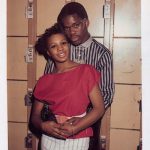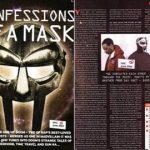Los Angeles, April 3, 2003. Deep in the labyrinth backstage environs of Hollywood’s Peter Fonda Theatre, the cream of the West Coast’s underground hip hop scene are having a bit of a party, albeit a very laid-back one. Grey Goose vodka is sipped, smoking laws are flouted with pungent, eye- reddening blunts. The atmosphere is warm, relaxed and shot through with a sense of B- boy camaraderie. Beat Junkies pound flesh with Jurassic 5ers; Common moves enigmatically through the assembled, entourage in tow, greeting friends arid well- wishers as he goes.
Out front, however, things couldn’t be more different. Already whipped into a funked-up frenzy by a storming set from Jay Dilla and Madlib (aka hip hop supergroup Jaylib), the 2,000-strong capacity crowd hit hysteria pitch when metal-masked, multi-persona’d, underground rhymesmith par excellence MF DOOM (yep, it’s all caps) hits the stage. He’s here to run through highlights from his and Madlib’s superlative ‘Madvillainy’ opus. And despite the fact said opus has only been on the streets for four days, as DOOM launches, accompanied by Madlib on drums, into album opener Accordion’, the kids know – and chant along to – every single word. You could cut the adoration with a knife.Eight hours earlier, reclining on the balcony of Stones Throw’s damn-near palatial suburban pad, MF DOOM – or Daniel Dumile, or King Geedorah, or Viktor Vaughn, or Zev Love X of early ’90s firebrands KMD – sips on a Heineken and admires the view – breathtaking, even on an overcast afternoon such as this. “It’s cool, isn’t it?” he grins. “I wrote most of the rhymes for ‘Madvillainy’ sat right here.” Madlib, the other half of Madvillain, hangs sleepily indoors, dressed head-to-toe in gleaming white, sphinx-inscrutable and almost supernaturally charismatic. Both men are notoriously interview-phobic, with DOOM (who appears to have drawn the short straw in the album promotion stakes) initially agreeing to speak to Jockey Slut only if he could wear his mask throughout. Thankfully, as it turns out, he’s not only sans mask, but friendly, eager to chat and, given the level of fevered fan worship he enjoys, refreshingly down-to-earth and ego-free.
You decided against wearing the mask?
“Yeah, I was gonna, but it woulda been too much (laughs). It’s bad enough I’ve got to wear it for 30 minutes onstage…”
Why do you wear it, both onstage and in publicity shots?
“I learned my lesson from the KMD days: you have to trade in your privacy to be in the public eye. So I said, ‘Yo, I still want to get my point across, and I still want to express myself, but I want to be able to walk down the street like a normal dude’. The mask absorbs a lot of that, it’s a buffer zone, y’know what I mean?
“Also, I saw hip hop start to go in a different direction between ’91 and ’94. It became all about the gear you wore, who the ‘coolest’ guy was. It wasn’t about that to me; it was all about the rhymes. The mask helps to defeat all that. It just becomes all about the beats and the rhymes.”
How much of ‘you’ is in MF DOOM or King Geedorah, or Zev Love X?
DOOM is probably the closest to me, the ‘normal’ me. He’s probably 99.9 per cent me. I say that 0.1 per cent so I won’t get in trouble with my wife (laughs)! Geedorah, I agree with him 100 per cent, but he says things I wouldn’t actually say myself. And Zev… At one time, around ’89 to ’90, Zev was 100 percent me. I was 18 at the time, and obviously as time goes on you don’t think the same, so now I probably agree with about 50 per cent of Zev’s ideology.
How closely related is MF DOOM to the Marvel Comics character Dr. Doom (who, for the uninitiated, was a metal-masked ‘supervillain’ loner)?
“I first got the whole ‘DOOM’ thing from my last name, Dumile (pronounced ‘doom-ee-lay’). Most of my friends when I was a kid couldn’t pronounce it, so they’d call me Doom. At the time I was collecting comics, and I made the connection between me and Dr Doom. I was like, ‘Yeah, that’s me!’ Doom was a character I always respected. He was considered a villain, a bad guy, but the way they wrote his stories you could sympathize with his struggle. There were reasons why he was the way he was. A lot of the time during adolescence you’re ostracised, you don’t fit in with the crowd, and when I had those times I was like, ‘Airight, I’m like Doom’.
“I gotta say that that whole era of Marvel, and Godzilla (from which Geedorah is borrowed), even the music of that time – it’s all ingrained in me, so what I give back is going to show that. I guess a lot of people who are from my era can identify with characters like Geedorah, and once they’re ‘in’ I can drop other jewels that they probably wouldn’t tap into if I came at them a bit ‘hard’ with an extra militant black power style. I don’t want to alienate anybody.” Comic book characters, mythical Japanese monsters, attention-diverting disguises… It’s fair to say that MF DOOM isn’t like other rappers. Having started his career in the late ’80s alongside his (now sadly deceased) brother Sub Roc as one-third of conscious rap crew KMD – whose ‘Black Bastards’ album was deemed too incendiary for release by their label – he rose to solo fame on the crest of the late ’90s indie hip hop wave, producing one of the era’s defining moments in the still-brilliant ‘Operation Doomsday’ album. His woozy, self-produced beats, hypnotic flow and dizzying, vivid wordplay were so peerless that he retained a fiercely loyal following even as most hip hop heads shifted their attention away from often tired-sounding underground rap towards the relatively mainstream likes of OutKast and Jay-Z. It was this very loyalty that allowed him to release commercially viable albums in the guise of a giant three-headed space-lizard (King Geedorah’s ‘Take Me To Your Leader’) while most other rappers were concerning themselves with little more than cars, clothes and crime.
For many, it’s DOOM’s bizarre (and yet somehow logical) album concepts that mark him out as a special talent. The next MF DOOM album, for example, is to be entitled MM FOOD (d’you see what he’s done there?), with every track themed around a particular foodstuff. “For example, there’s a track called ‘Cookies’ on there, about the cookies you get on your computer from surfing porn sites,” he says, visibly amused by his own demented imagination. “I’ve got the cow from ‘Sesame Street’ talking to Grover and the Cookie Monster on that one. There’s gonna be some cheese salad joints on there as well.”
Like we said, he’s not like other rappers. Accordingly, he’s chosen to collaborate with somebody who’s not like other producers. Since making his mark as beatsmith for fondly-recalled ’90s crew Lootpack, Otis ‘Madlib’ Jackson Jr has spent the last few years dazzling and dismaying in equal measure, producing increasingly boundary- testing music, at an astonishing rate and via a variety of aliases – including stints as The Beat Conductor, as helium-voiced MC Quasimoto and as all five ‘members’ of lounge-funk ‘outfit’ Yesterday’s New Quintet. The parallels between his and DOOM’s career are remarkable; it’s no surprise when DOOM says that he feels like he’s found his musical soulmate in Jackson.
“Collaborating with him has been like collaborating with a brother I never knew I had,” he says. “We clicked immediately. You know how children automatically click? You just wanna go, ‘Let’s play!”
There’s certainly a sense of childlike wonderment running through ‘Madvillainy’. A non-stop, flowing soundscape – rather than a collection of disparate tracks – it leaps excitedly around from idea to idea, abruptly changing shape the second the listener thinks they’ve got a handle on it. It’s barely recognisable as hip hop in the accepted contemporary sense, and, in terms of scale and ambition, seems to have more in common with the psychedelic jazz/soul sounds purveyed by the likes of Sun Ra in the ’70s. “Yeah, Sun Ra was really cool,” DOOM enthuses. “Otis (Madlib) really put me on to him. All that Space Is The Place-type shit, from my understanding it’s a way to transcend all the shit that’s happening to people at the minute. He also showed me that time doesn’t really exist; you can deal with it if you want, but if not, you can just step out of it.”
Has jazz as a whole been aninspiration to him?
“Definitely. People like Ornette Coleman or John Coltrane chose to go in directions that people couldn’t accept. But now, their stuff’s seen as ‘classic’. That helped to show me that even if people don’t get what I’m doing now, they’ll get it eventually.”
Him and Madlib are clearly not overly concerned with pushing their Madvillain project mainstream-wards; in a genre obsessed with hyper-catchy verbal hooklines, they’ve managed to produce a 22-track album that features not one chorus. “I try and stay away from the use of repetitive choruses,” says DOOM. “Every rhyme is a chorus. You don’t really need a chorus to keep everybody hypnotised into the thing.” Again, like we said, he’s not like other rappers…
Which other rappers are you into?
“Umm…” (considers deeply)
Nobody?
“I don’t really listen to rap shit too much. I’m into Medaphoar – that cat is an ill MC.But if I had to name anybody, it’d be cats that are already out, like Nas and Ghostface. They take the time out to drop a message. The bragging about gold and that is cool, but you have a responsibility to put at least one song on your shit that might help somebody.
“I look at DOOM as representing the average Joe. The outlaw can sympathise with DOOM, or the cat who doesn’t have too many friends, or the cat who doesn’t have the best sneakers on. If you’re not as cool as Jay-Z, you don’t have enough money to buy his records, or buy a gold chain – I don’t wear no chain, I’m your man, yo. I’m the one you can relate to. I got a potbelly. Come holler at me!”

